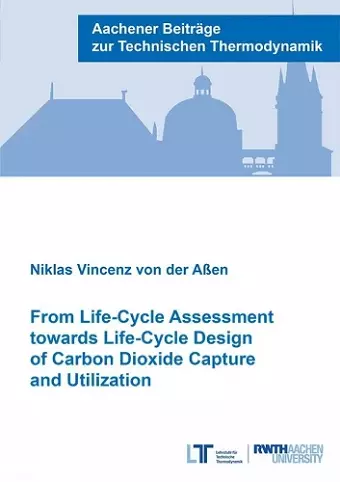From Life-Cycle Assessment towards Life-Cycle Design of Carbon Dioxide Capture and Utilization
Format:Paperback
Publisher:Verlag G. Mainz
Published:30th Jul '15
Should be back in stock very soon

Ever since humans have existed, they have impacted the earth in many different ways (Redman, 1999). Currently, important impacts are associated with the excessive use of non-renewable fossil fuels such as coal, oil and natural gas. Most fossil fuels are used for electricity generation, heating and mobility (eia, 2011), and as feedstock in the chemical industry (IEA et al., 2013). Moreover, the use of fossil fuels is associated with carbon dioxide emissions (CO2) (IEA, 2014; Leimk¨uhler, 2010). Emitting CO2 into the atmosphere leads to global warming and disrupts the natural carbon cycle (Stocker et al., 2013). To close the disrupted carbon cycle, CO2 can be captured and re-utilized, thereby mitigating global warming and saving fossil resources (Styring et al., 2014).
CO2 can be captured from current anthropogenic CO2 sources or directly from the atmosphere. Captured CO2 can then be utilized as valuable physical product “as such”or as alternative carbon feedstock for fuels, chemicals and materials. The general concept of CO2 Capture and Utilization (CCU) can be considered established: already today, CO2 is captured and utilized in processes in the chemical industry (Aresta et al., 2014). However, the scope of CO2 utilization is limited. Despite the existing industrial implementations as well as continuous progress and current efforts in CCU research, most CCU technologies are still in early stages of development. Besides the limited technological readiness, CCU is intrinsically challenging since both capture and utilization of CCU typically require substantial amounts of energy (Sakakura et al., 2007). If the provision of energy relies on fossil resources, indirect CO2 emissions are caused. Therefore, the intuitively expected environmental benefits from using CO2 are not given by default (Peters et al., 2011b). In fact, it cannot be ruled out that a tediously accomplished CCU process is finally environmentally less sustainable than a conventional fossil-based route. Therefore, it is desirable to know whether a specific CCU process is environmentally favorable. For this purpose, a reliable environmental assessment of CCU is required.
As indicators for the environmental performance of CCU, a large variety of approaches are proposed ranging from qualitative design principles (Anastas andWarner, 1998) and metrics for ‘green’ chemistry (Constable et al., 2002) to CCU-specific ad-hoc criteria (Peters et al., 2011b; M¨uller and Arlt, 2014). These approaches are rather intended to...
ISBN: 9783958860803
Dimensions: unknown
Weight: 314g
209 pages